Sony Bundle
How Does Sony Thrive in a Sea of Giants?
Sony, a titan in technology and entertainment, faces a dynamic and challenging Sony SWOT Analysis. From gaming to music and electronics, the company's success hinges on its ability to outmaneuver fierce rivals and anticipate market shifts. Understanding the Sony competitive landscape is crucial for anyone seeking to grasp the intricacies of this global powerhouse.
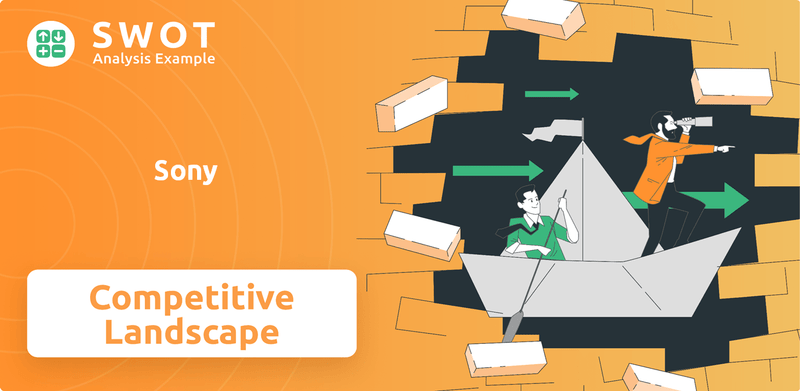
This analysis will dissect Sony's market analysis, revealing its key Sony competitors and the strategies it employs to maintain its edge. We'll explore the Sony industry dynamics, examining Sony's strategy for innovation and the Sony challenges it faces in a rapidly evolving world. Delving into these aspects will provide a comprehensive understanding of Sony's position and prospects.
Where Does Sony’ Stand in the Current Market?
Sony's market position is strong across various sectors, often leading or holding significant shares in key areas. The company's diverse portfolio includes gaming, imaging solutions, consumer electronics, and entertainment. This multifaceted approach allows Sony to leverage its strengths across different markets, creating a robust and resilient business model.
The company's core operations focus on creating and delivering innovative products and services. Sony's value proposition centers on combining cutting-edge technology with compelling content. This strategy aims to provide consumers with immersive entertainment experiences and high-quality products, which helps to solidify its market position. For an in-depth look at the company's structure, consider the perspective of Owners & Shareholders of Sony.
In the gaming sector, Sony's PlayStation brand is a leader, particularly in the console market. As of March 2024, the PlayStation 5 had sold over 59.3 million units globally. This success is supported by an extensive game library and a growing PlayStation Plus subscriber base, which reached 49.3 million by March 31, 2024.
Sony is a global leader in image sensors, especially for mobile devices. In 2023, the company held approximately a 49% market share in this area. This strong position is a key factor in the company's overall competitive landscape.
Sony's financial health remains robust. For the fiscal year ending March 31, 2024, the company reported sales and operating revenue of 11,539.8 billion yen (approximately 77.2 billion USD). This financial strength supports its investments in innovation and market expansion.
Geographically, Sony has a significant presence in North America, Europe, and Asia. The company is strategically shifting towards a more content-centric model, leveraging its hardware to drive software and subscription revenues. This approach enhances its position in the entertainment market.
Sony's competitive advantages include its strong brand reputation, technological innovation, and diverse product portfolio. The company faces intense competition in consumer electronics from various global players. Understanding the Sony competitive landscape is crucial for investors and analysts.
- Gaming: PlayStation's strong market share and exclusive game titles.
- Imaging: Leadership in image sensors for mobile devices.
- Entertainment: Integration of hardware, software, and content.
- Financial Strength: Robust revenue and strategic investments.
Sony SWOT Analysis
- Complete SWOT Breakdown
- Fully Customizable
- Editable in Excel & Word
- Professional Formatting
- Investor-Ready Format
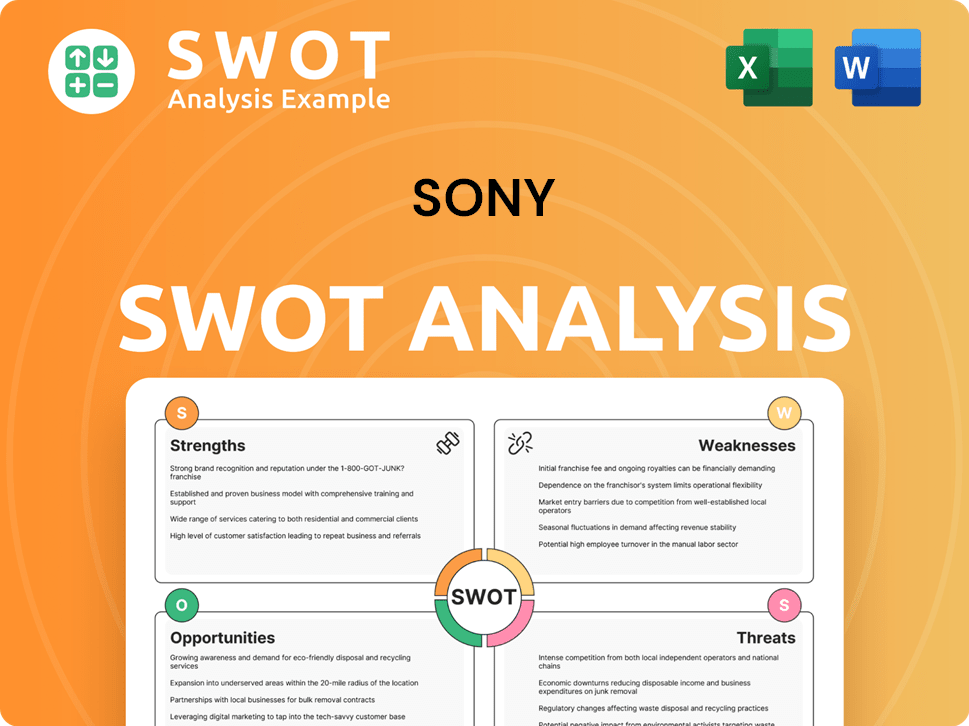
Who Are the Main Competitors Challenging Sony?
The Brief History of Sony reveals a company navigating a complex and evolving competitive environment. Analyzing the Sony competitive landscape requires understanding its diverse business segments, each facing unique challenges and rivals. This analysis is crucial for investors, strategists, and anyone interested in the company's future.
Sony's market analysis shows a company that thrives on innovation and adaptation. From gaming to entertainment and electronics, Sony's ability to stay competitive depends on its strategic responses to both established and emerging competitors. Understanding these dynamics is key to assessing Sony's long-term prospects.
Sony's competitive landscape is shaped by its diverse business segments, each with distinct rivals and market dynamics. The company's success hinges on its ability to innovate, adapt, and maintain a strong market position against its competitors.
In the gaming sector, Microsoft, with its Xbox console line and Game Pass subscription service, is a primary competitor. Nintendo, with its Switch console, also presents a strong challenge, particularly in the portable and family-friendly gaming markets.
Sony's electronics segment faces stiff competition from Samsung and LG in televisions, holding significant market shares. Canon and Nikon remain strong in cameras, especially in the professional and enthusiast segments. Apple and Samsung also challenge the compact camera market.
Sony Music Group competes with Universal Music Group and Warner Music Group for artist talent and market share. Sony Pictures Entertainment faces major Hollywood studios like Disney and Warner Bros. Discovery in film production and distribution.
While Sony holds a dominant position, competitors like Samsung and OmniVision are actively investing in sensor technology. The financial services segment primarily competes with domestic Japanese financial institutions.
The competitive landscape is also being shaped by emerging players in various tech sectors and potential cross-industry collaborations or disruptions. Sony must adapt to remain competitive.
In fiscal year 2024, Sony's Game & Network Services segment saw revenue of approximately ¥4.26 trillion, while the Pictures segment generated about ¥1.49 trillion. These figures highlight the competitive pressures and the need for strategic focus across all segments.
Sony's competitive strategies involve product innovation, strategic partnerships, and market diversification. The company's ability to adapt to changing consumer behavior and emerging technologies is critical.
- Gaming: Microsoft's Xbox and Nintendo's Switch. Sony focuses on exclusive game titles and the PlayStation ecosystem.
- Electronics: Samsung and LG in TVs; Canon and Nikon in cameras. Sony emphasizes premium products and advanced technology.
- Entertainment: Disney, Warner Bros. Discovery, and Universal Pictures. Sony focuses on content creation and distribution across multiple platforms.
- Music: Universal Music Group and Warner Music Group. Sony leverages its artist roster and global distribution network.
- Imaging and Sensing: Samsung and OmniVision. Sony invests in sensor technology and partnerships.
Sony PESTLE Analysis
- Covers All 6 PESTLE Categories
- No Research Needed – Save Hours of Work
- Built by Experts, Trusted by Consultants
- Instant Download, Ready to Use
- 100% Editable, Fully Customizable
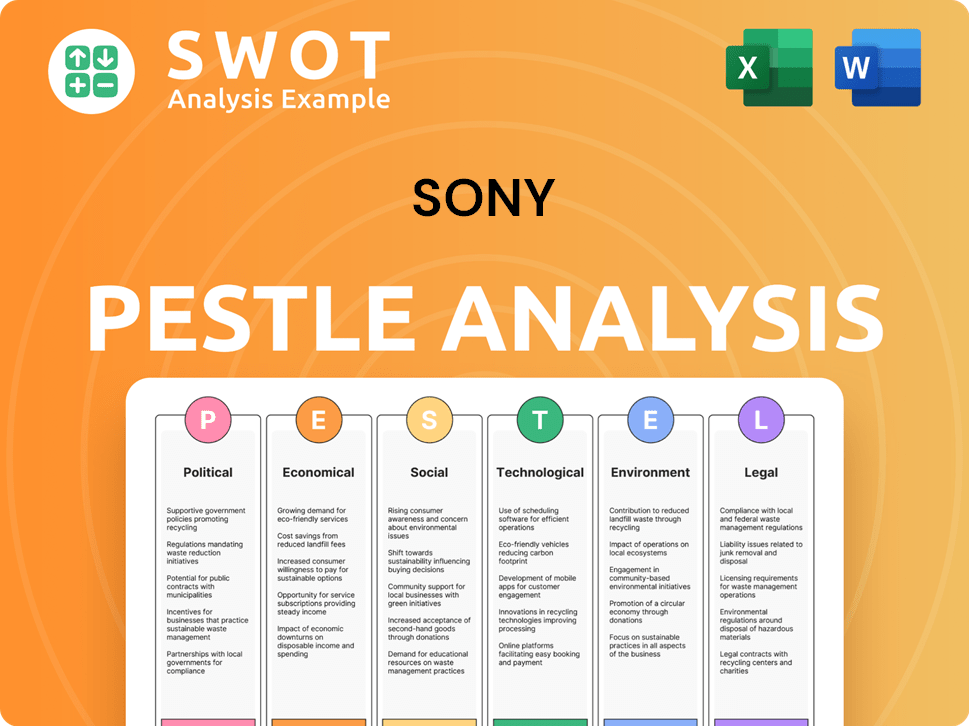
What Gives Sony a Competitive Edge Over Its Rivals?
The competitive advantages of Sony are significant, stemming from its strong brand recognition, technological leadership, diverse business portfolio, and integrated ecosystem. Its brand, synonymous with innovation and quality, fosters customer loyalty across various product lines, allowing it to command premium pricing. This is evident in its PlayStation consoles, Alpha cameras, and Bravia televisions. The company's ability to integrate hardware, software, and content creates a distinct edge over competitors.
Technological prowess, particularly in imaging and sensing solutions, is a cornerstone of Sony's advantage. Its image sensors are widely adopted in smartphones and other devices, providing a robust revenue stream and a strategic position in the mobile technology supply chain. In gaming, PlayStation benefits from exclusive first-party titles, robust online services, and a strong developer community, creating a network effect that enhances user retention. This is crucial in today's dynamic market, where consumer preferences and technological advancements are constantly evolving.
Sony's diverse portfolio, spanning hardware, software, and content, allows for synergistic opportunities. For example, its music and film divisions create content that leverages its electronic devices and gaming platforms, fostering an integrated entertainment experience. This vertical integration, from content creation to distribution, provides a distinct edge over competitors. Furthermore, economies of scale in manufacturing and global distribution networks contribute to cost efficiencies and wider market reach. To understand more about their business model, check out Revenue Streams & Business Model of Sony.
Sony's strong brand equity, built over decades, allows it to command premium pricing and maintain customer loyalty. This is particularly evident in the gaming sector, where the PlayStation brand consistently ranks high in consumer preference. The company's focus on quality and innovation reinforces its brand image, helping it to compete effectively in various markets.
Sony's technological expertise, especially in imaging and sensing, provides a significant competitive advantage. Its image sensors are used in a wide range of devices, including smartphones, giving it a strong position in the mobile technology supply chain. The company's investment in R&D helps it stay ahead in innovation.
Sony's diverse portfolio, spanning hardware, software, and content, allows for synergistic opportunities. The company's ability to integrate its various business segments, such as music, film, and gaming, provides a unique competitive advantage. This integration enhances the user experience and creates additional revenue streams.
The integrated ecosystem of Sony, particularly in gaming, creates a strong network effect. PlayStation's exclusive titles, online services, and developer community enhance user retention and attract new players. This ecosystem approach helps Sony maintain a competitive edge in the entertainment market.
Sony's competitive advantages are rooted in its brand strength, technological innovation, and diversified business model. The company's ability to integrate hardware, software, and content creates a unique ecosystem that enhances user experience and drives customer loyalty. While facing challenges, Sony's strategic focus on these areas positions it well in the evolving market.
- Strong Brand: Sony's brand is globally recognized for quality and innovation, fostering customer loyalty.
- Technological Prowess: Leadership in imaging and sensing, along with continuous R&D, sustains a competitive edge.
- Diverse Portfolio: Spanning hardware, software, and content, creating synergistic opportunities.
- Integrated Ecosystem: Vertical integration from content creation to distribution provides a distinct edge.
Sony Business Model Canvas
- Complete 9-Block Business Model Canvas
- Effortlessly Communicate Your Business Strategy
- Investor-Ready BMC Format
- 100% Editable and Customizable
- Clear and Structured Layout
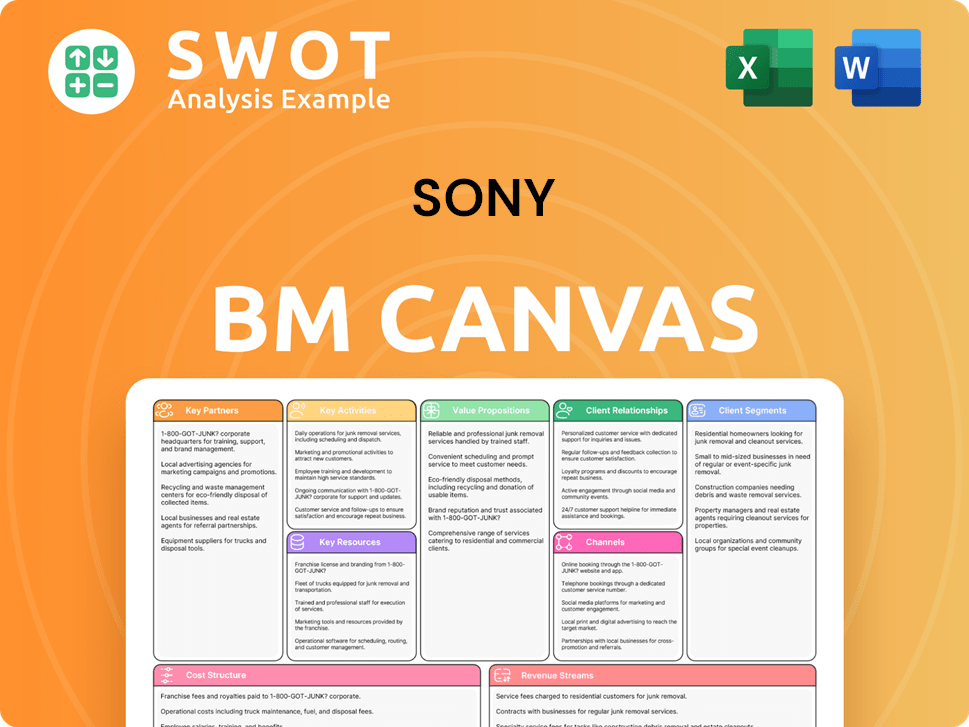
What Industry Trends Are Reshaping Sony’s Competitive Landscape?
The competitive landscape for Sony is shaped by dynamic industry trends, presenting both risks and opportunities. Understanding these factors is crucial for assessing its future prospects. This analysis explores key industry trends, challenges, and opportunities impacting Sony, providing insights for investors and stakeholders.
The company's strategic positioning requires adaptation to digital distribution, AI, and sustainability. Navigating supply chain issues and intense competition are critical. Conversely, expanding into new markets and leveraging its intellectual property offer significant growth potential. A deep dive into these elements is essential for a comprehensive Sony market analysis.
Digital distribution and subscription models are transforming gaming, music, and film. Artificial intelligence (AI) offers opportunities for enhanced experiences and operational efficiencies. Consumer demand for sustainable products influences manufacturing and supply chain practices. These trends significantly impact the Sony industry.
Supply chain disruptions and content production costs are ongoing concerns. Intense competition from tech companies in entertainment and hardware poses a threat. Evolving regulations regarding data privacy and content censorship could impact global operations. These challenges require strategic responses for sustained success.
Expansion into emerging economies offers growth potential for electronics and entertainment. Leveraging intellectual property across segments can unlock new revenue streams. Innovation in VR, AR, and image sensors could create new markets. Strategic partnerships, particularly in AI and cloud computing, can bolster competitiveness.
Agility, continuous innovation, and effective integration of diverse offerings are crucial. Adaptability to changing consumer behavior is essential for long-term success. Strategic partnerships and acquisitions in key areas like AI are vital. Understanding Sony's marketing strategy is essential for investors.
Sony's competitive landscape is influenced by its ability to adapt to technological advancements and market shifts. The company's financial performance compared to competitors will depend on its strategic choices. The ability to innovate and effectively manage its diverse portfolio will be critical for sustained growth. Understanding these factors is important for a thorough Sony market analysis.
- Capitalizing on digital distribution trends in gaming and music.
- Investing in AI to enhance user experiences and operational efficiency.
- Expanding into new geographic markets, especially in emerging economies.
- Leveraging intellectual property through film adaptations and music.
Sony Porter's Five Forces Analysis
- Covers All 5 Competitive Forces in Detail
- Structured for Consultants, Students, and Founders
- 100% Editable in Microsoft Word & Excel
- Instant Digital Download – Use Immediately
- Compatible with Mac & PC – Fully Unlocked
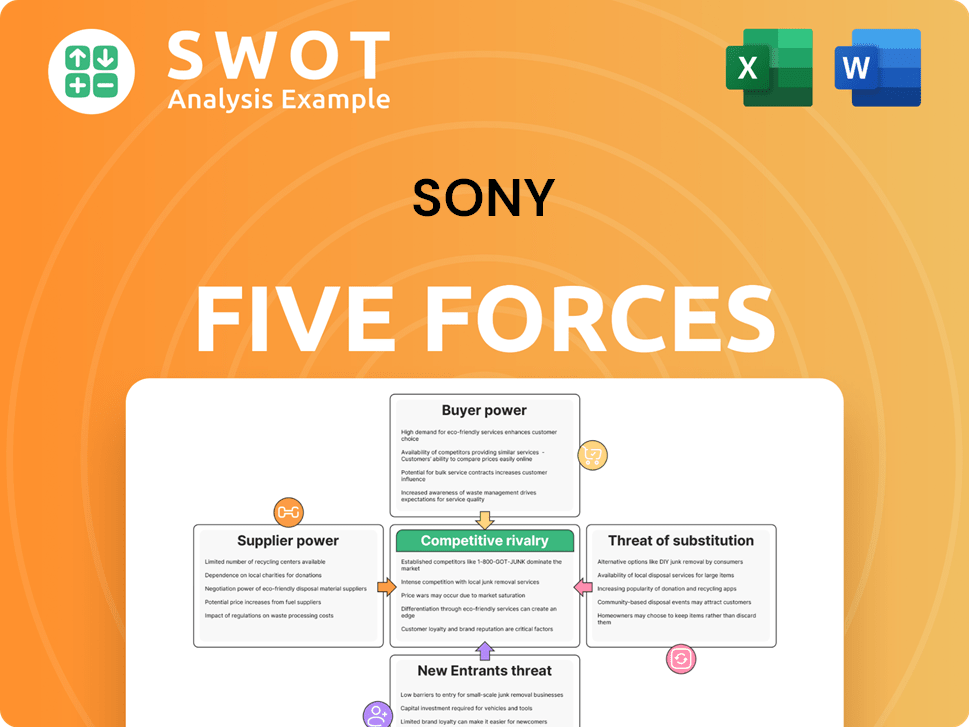
Related Blogs
- What are Mission Vision & Core Values of Sony Company?
- What is Growth Strategy and Future Prospects of Sony Company?
- How Does Sony Company Work?
- What is Sales and Marketing Strategy of Sony Company?
- What is Brief History of Sony Company?
- Who Owns Sony Company?
- What is Customer Demographics and Target Market of Sony Company?
Disclaimer
All information, articles, and product details provided on this website are for general informational and educational purposes only. We do not claim any ownership over, nor do we intend to infringe upon, any trademarks, copyrights, logos, brand names, or other intellectual property mentioned or depicted on this site. Such intellectual property remains the property of its respective owners, and any references here are made solely for identification or informational purposes, without implying any affiliation, endorsement, or partnership.
We make no representations or warranties, express or implied, regarding the accuracy, completeness, or suitability of any content or products presented. Nothing on this website should be construed as legal, tax, investment, financial, medical, or other professional advice. In addition, no part of this site—including articles or product references—constitutes a solicitation, recommendation, endorsement, advertisement, or offer to buy or sell any securities, franchises, or other financial instruments, particularly in jurisdictions where such activity would be unlawful.
All content is of a general nature and may not address the specific circumstances of any individual or entity. It is not a substitute for professional advice or services. Any actions you take based on the information provided here are strictly at your own risk. You accept full responsibility for any decisions or outcomes arising from your use of this website and agree to release us from any liability in connection with your use of, or reliance upon, the content or products found herein.